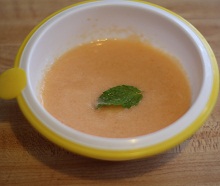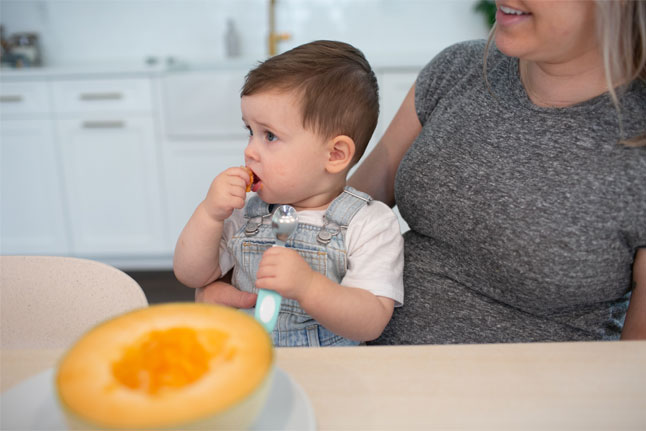Stage 3

This refreshing soup is the perfect meal on a hot day.
- 1 whole lime
- 1 1/4 cup water
- 1/2 cup fresh mint leaves
- 1 cantaloupe (approx 2 1/2 pounds)
- 1/3 cup plain yogurt
- 1/4 cup agave or honey (optional)
- 2 fresh mint leaves for garnish
Note* The American Academy of Pediatrics recommends waiting to offer honey to children until after their first birthday.
With a vegetable peeler remove zest from lime in strips and juice the lime. In a saucepan simmer water, zest, mint, and agave or honey (if desired), stirring occasionally for 5 minutes. Remove pan from heat and let mixture stand 15 minutes. Pour mixture through a fine mesh strainer into a bowl, and discard solids. Cool syrup to room temperature.
Halve and seed cantaloupe. Scoop flesh into a blender with yogurt, lime juice and purée with syrup until smooth, transferring to a large bowl. Chill soup, covered, until cold, at least 2 hours, and up to 1 day. Skim any foam from top. Serve soup garnished with mint.
Recipe Yields: 6 Servings
Storage Time: 3 days in the refrigerator
This recipe is an excellent source of Vitamin A and Beta-Carotene. Both of these nutrients contribute to maintaining healthy eyesight.
Stage 1 + 2

By combining cantaloupe with blueberries, you can introduce new flavors to your baby in a simple dish that is packed with nutrients and anti-oxidants.
- 1/2 cup diced cantaloupe
- 1/2 cup blueberries
Puree each separately. Fill bowl half with cantaloupe (consider the bowl a clock and the half mark is 12 and 6), the other half is the blueberry puree. Now using a spoon swirl the blueberry puree into the cantaloupe for a fun design, it gives baby a taste of both while leaving part of the puree as a single flavor.
You can also try substituting the blueberry with:
Peach
Banana
Avocado
Raspberry
Recipe Yields: 2 Servings
Store the remaining puree in the freezer storage pods to use later. You can store the fruit purees separately or mix together and then freeze.
Storage Time: 3 months in the freezer
Cantaloupe is an excellent source of vitamin and A & C.
Stage

The ABCs Of Vitamin C
Vitamin C is critical for health and growth in infancy. This essential vitamin promotes a strong immune system, the growth and maintenance of healthy skin and red blood cells, plus is necessary to build collagen, which helps to form connective tissue that binds muscles, bones, and tissue together. Vitamin C is also known to increase wound healing, while preventing infections and, as an antioxidant, helps protect against diseases such as cancer, heart disease, and arthritis in the future.
While you may have heard these important vitamin C facts from your pediatrician, it may come as a surprise to learn of the many unexpected ways to ensure your little one is getting adequate amounts of vitamins. When baby starts using solid foods as their primary source of nutrition, they should consume foods high in vitamin C daily. Note that most pediatricians suggest infants 7 to 12 months should consume 50 mg. of vitamin C a day, while children 1 to 3 years should have at least 15 mg. a day. To ensure your baby is getting enough vitamin C, try some common (oranges) and uncommon (zucchini) with them. Let’s take a look at some of the common and uncommon sources of vitamin C.
Citrus fruits.
You probably already know about this vitamin C option. Oranges, lemons, grapefruits, and tangerines are just a few of the many types of citrus fruits. They’re well-known for their high vitamin C content. Diluting the juice in water, pureeing, or simply eating the fruit as is-are all excellent ways to introduce your child to these sweet, colorful, and vitamin C-rich foods.
Tomatoes.
Foods like pizza, spaghetti, tomato soup and even ketchup are known to be loved by most little ones. Believe it or not these tomato-based foods are all sure-fire ways to get your little one to sneak in some extra vitamins, including vitamin C! For instance, a 10-ounce serving of tomato soup offers 6.4 mg. of vitamin C. Tomatoes are versatile, try a couple of varieties with your little one to find which they like best.
Sweet potatoes.
This bright and sweet vegetable is ideal for when your baby first begins to eat solids. They contain a wide range of nutrients and can be prepared in a variety of ways. A common way for parents to introduce sweet potatoes is during baby-led weaning, by cooking and mashing them to an appropriate consistency. As your little one progresses in their solid food journey, experiment with different preparations, such as sweet potato French fries.
Cantaloupe.
This child-popular melon is also a great source of vitamin C. A sweet fruit option that can be introduced to baby as soon as they begin eating foods like purees. It’s rich in vitamin C and other essential vitamins. Just one-quarter of a medium cantaloupe features an eye-opening 47 mg. of vitamin C This fruit’s preparation is critical because it can pose a choking hazard if not done correctly.
Watermelon.
Watermelon is a nutritious treat for your little one that is sweet, juicy, and contains approximately 92%1 water. It’s rich in antioxidants, including vitamin C, which can help strengthen baby’s immune system. Like many of the other fruits listed, there is a variety of ways to introduce your little one to this delicious fruit.
Zucchini.
Just one cup on zucchini contains 11 mg. of vitamin C and helps add even more healthy variety to your child’s daily diet. Zucchini can be roasted, steamed, sautéed, or pureed. Pureeing it and making it a sauce with pasta is a sneaky way to sneak this vegetable into your child’s diet (especially if they’re picky).
While offering your toddler a piece of fruit with each meal is a good idea, try introducing other lesser-known sources of vitamin C, such as those listed above, to help provide your toddler with a well-balanced diet that provides multi-vitamin and nutritional benefits.









